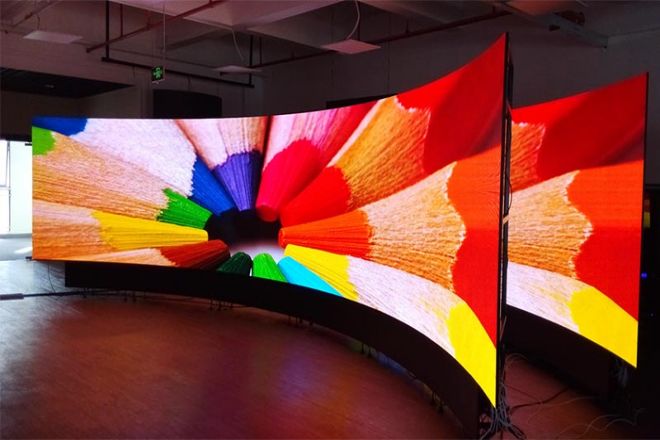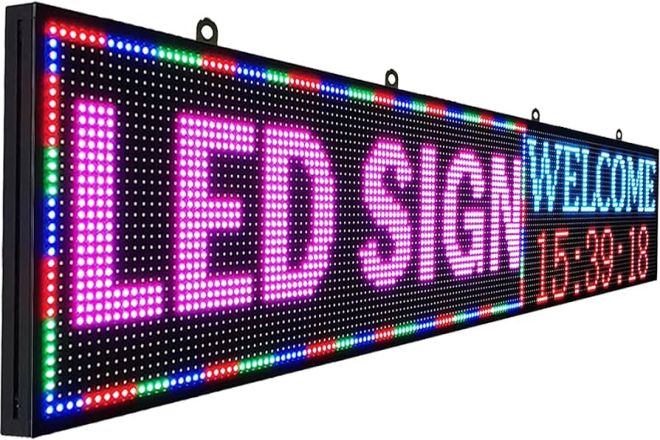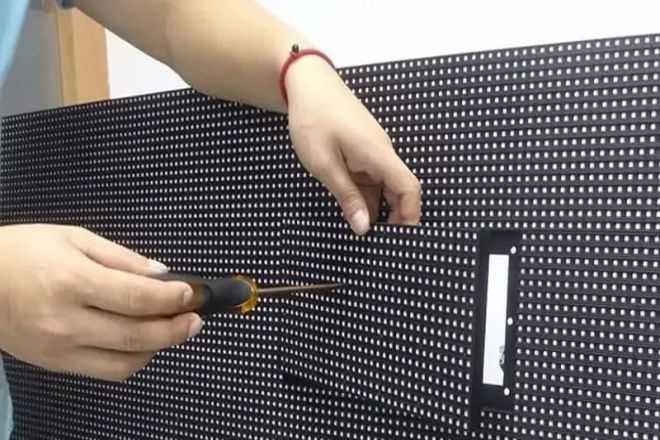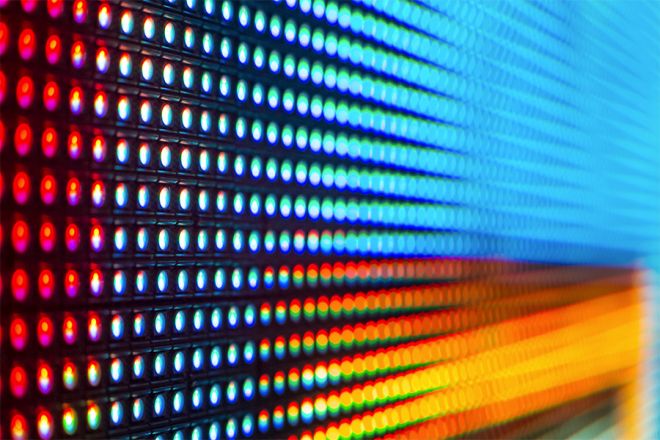مقدمة

ومع التطور السريع للعلوم والتكنولوجيا، يعرض الصمام أصبحت شاشات LED جزءًا لا غنى عنه في حياتنا. سواء في مراكز التسوق أو الملاعب أو اللوحات الإعلانية الخارجية أو المعارض، فقد جذبت شاشات LED انتباه عدد لا يحصى من الناس بألوانها الزاهية وجودة الصورة عالية الدقة وطرق العرض المرنة.
ومع ذلك، بالنسبة للعديد من الناس، لا تزال شاشات LED مجالًا غامضًا ومعقدًا. ستوفر لك هذه المقالة دليلًا لمعرفة شاشات LED من المبتدئين إلى الخبراء، مما يساعدك على فهم مبدأ عمل شاشات LED وشراءها واستخدامها وصيانتها واتجاهات تطوير التكنولوجيا الخاصة بها بشكل كامل.
1. المعرفة الأساسية بشاشات العرض LED

1) مبدأ انبعاث الضوء LED
يمكن تشبيه LED (الصمام الثنائي الباعث للضوء) مجازيًا براقصة على مسرح مصغر.
تخيل أن الجزء الداخلي من الصمام الثنائي الباعث للضوء يشبه المسرح، وأن جوهر المسرح هو الراقص الذي يؤدي العرض - وهو عبارة عن شريحة أشباه الموصلات.
يقف الراقص على حامل خاص، مع وضع قدمه اليسرى (القطب السالب) بقوة على الحامل، وتكون قدمه اليمنى (القطب الموجب) متصلة بشكل وثيق بمصدر الطاقة كما لو كانت تُسحب بواسطة سلك غير مرئي.
يحيط ستار شفاف (راتنج إيبوكسي) بالمسرح بأكمله، مما يضمن سلامة المؤدين ويسمح للجمهور برؤية الأداء بوضوح.
عندما يتدفق التيار إلى هذه المرحلة عبر مصدر الطاقة، فإنه يشبه قوة غير مرئية تدفع الراقصة إلى البدء في الرقص. وتحت تأثير هذه القوة، تبدأ الراقصة (الإلكترون) في التحرك إلى منطقة معينة من المرحلة (المنطقة P).
هناك، يلتقي براقصة أخرى خاصة. عندما يلتقي الاثنان ويعملان معًا عن كثب (مركب)، يطلقان ضوءًا لامعًا رائعًا مثل الألعاب النارية على المسرح. هذا هو مبدأ مصابيح LED التي تصدر الضوء.
يمكن أن يصدر مصباح LED ألوانًا مختلفة من الضوء، اعتمادًا على نوع الراقص المستخدم على المسرح. يطلق الراقصون (المواد) المختلفون طاقة بترددات مختلفة عندما يعملون معًا، مما ينتج عنه ألوان مختلفة من الضوء. الأمر أشبه باستخدام ألوان مختلفة من الأضواء على المسرح، مما يجعل الأداء بأكمله أكثر تنوعًا.
2) تصنيف شاشات LED
- التصنيف حسب درجة البكسل:
كلما كانت درجة البكسل في الشاشة أصغر، كلما كان تأثير العرض أكثر دقة. على سبيل المثال، شاشات LED ذات درجة البكسل الصغيرة مناسبة للمناسبات التي تتطلب شاشات عالية الدقة، مثل غرف المؤتمرات ومراكز المراقبة وما إلى ذلك.
- التصنيف حسب لون العرض:
يمكن لشاشات العرض LED عرض مجموعة متنوعة من الألوان، بما في ذلك أحادية اللون (مثل الأحمر والأخضر)، والألوان المزدوجة (مثل الأحمر والأخضر والأحمر والأزرق)، والألوان الكاملة (الأحمر والأخضر والأزرق وRGB). شاشات العرض LED بالألوان الكاملة غنية بالألوان وتستخدم على نطاق واسع في الإعلانات الخارجية وخلفيات المسرح وغيرها من المناسبات.
- التصنيف حسب وضع العرض:
هناك بشكل أساسي شاشات عرض ثابتة وشاشات عرض ديناميكية. يمكن لشاشات العرض الديناميكية عرض الرسوم المتحركة ومقاطع الفيديو وغيرها من المحتوى الأكثر حيوية وإثارة للاهتمام.
3) المعلمات الرئيسية لشاشات العرض LED
دقة: كلما زادت الدقة، كانت الصورة المعروضة أكثر وضوحًا. وعادةً ما يتم التعبير عنها بـ "عدد البكسل الأفقي × عدد البكسل الرأسي"، مثل 1920 × 1080.
سطوع: يحدد السطوع مدى رؤية الشاشة في ظل ظروف الإضاءة المحيطة المختلفة. وعادة ما تكون الوحدة هي cd/m² (كانديلا لكل متر مربع). تتطلب شاشات العرض LED الخارجية سطوعًا أعلى لتظل مرئية في ظل الضوء القوي.
مقابلة: يشير التباين إلى الفرق بين البكسلين الأكثر سطوعًا والأكثر قتامة اللذين تعرضهما شاشة العرض في نفس الوقت. يمكن للتباين الأعلى تعزيز تفاصيل الصورة وتشبع ألوانها.
زاوية الرؤية: تحدد زاوية العرض نطاق الزاوية التي تظل الصورة مرئية بوضوح عند عرض شاشة العرض من اتجاهات مختلفة. وعادة ما يتم التعبير عنها في اتجاهين أفقي ورأسي، مثل 120° × 120°.
معدل التحديث: يشير معدل التحديث إلى عدد المرات التي تقوم فيها الشاشة بتحديث الصورة في الثانية. يمكن لمعدل التحديث الأعلى توفير تأثير عرض أكثر سلاسة، وتقليل وميض الشاشة وتذبذب الألوان. تتضمن معدلات التحديث الشائعة 60 هرتز و120 هرتز وما إلى ذلك.
تدرج الرمادي: يشير مصطلح تدرج الرمادي إلى مستويات السطوع المختلفة التي يمكن للشاشة عرضها. ويمكن لمستويات تدرج الرمادي الأعلى توفير صور أكثر دقة وتعبيرًا أكثر ثراءً عن الألوان.
استهلاك الطاقة: يشير استهلاك الطاقة إلى الطاقة التي تستهلكها الشاشة أثناء التشغيل. يمكن أن يؤدي انخفاض استهلاك الطاقة إلى تقليل استهلاك الطاقة وتكاليف التشغيل.
وقت الاستجابة: يشير وقت الاستجابة إلى الوقت المطلوب لشاشة العرض لاستقبال إشارات الإدخال وعرض المحتوى المقابل. يمكن لوقت الاستجابة الأقصر أن يقلل من تشوه الصورة وعدم وضوحها ويوفر صورًا متحركة أكثر وضوحًا.
عمر: يشير مصطلح عمر الخدمة إلى عمر خدمة شاشة LED، أي الوقت الذي يمكنها فيه الحفاظ على التشغيل العادي في ظل ظروف العمل العادية. وعادةً ما يتم التعبير عن عمر خدمة شاشة LED عالية الجودة بالساعات، ويمكن أن يصل إلى عشرات الآلاف من الساعات.
2. شراء وتركيب شاشات LED
1) دليل الشراء
1.1). اعتبارات سيناريو التطبيق:
داخلي/خارجي: تحتاج شاشات العرض الخارجية إلى مراعاة خصائص مقاومة الماء والغبار وأشعة الشمس وغيرها من الخصائص، مثل اختيار المنتجات ذات مستوى الحماية IP65 أو أعلى.
عرض المسافة: اختر شاشة عرض بحجم مناسب وفقًا لمسافة المشاهدة. على سبيل المثال، لمسافة مشاهدة تتراوح بين 2.5 و3 أمتار، يوصى باختيار شاشة مقاس 55 بوصة.
عرض المحتوى: إذا كنت بحاجة إلى عرض مقاطع فيديو أو صور عالية الدقة، فيجب عليك اختيار شاشة ذات دقة عالية ومعدل تحديث مرتفع.
1.2) اعتبارات الميزانية:
تختلف أسعار شاشات العرض LED ذات الأحجام والتكوينات والعلامات التجارية المختلفة بشكل كبير. وفقًا لنطاق الميزانية، اختر المنتج الأكثر فعالية من حيث التكلفة.
احرص على عدم السعي وراء الأسعار المنخفضة بشكل أعمى حتى لا تضحي بالجودة والأداء.
1.3). العلامة التجارية وخدمة ما بعد البيع:
اختر العلامات التجارية المعروفة مثل Hisense و TCL و Samsung وغيرها لضمان جودة المنتج واستقراره.
خذ في الاعتبار خدمة ما بعد البيع، بما في ذلك الدعم في التثبيت، وتصحيح الأخطاء، والصيانة، وما إلى ذلك.
2) خطوات التثبيت
2.1). اختيار موقع التثبيت:
اختر سطح تثبيت مستوٍ وصلب للتأكد من أن الشاشة مستقرة ولا تهتز.
يجب مراعاة ظروف التهوية وتبديد الحرارة لتجنب ارتفاع درجة حرارة شاشة العرض والتأثير على عمرها الافتراضي.
عند التثبيت في الهواء الطلق، انتبه إلى الحماية من الصواعق، والحماية من المطر، والحماية من الشمس، وغيرها من التدابير.
2.2). تركيب القوس:
قم باختيار القوس المناسب وفقًا لحجم ووزن الشاشة.
تأكد من أن القوس أفقي ورأسي ومستقر عند تثبيته.
2.3). تجميع الشاشة:
قم بتجميع الشاشة وفقًا لدليل المنتج، وكن حريصًا على التعامل معها بحذر لتجنب التلف.
قم بتوصيل مصدر الطاقة وخط الإشارة وما إلى ذلك، للتأكد من أن الاتصال ثابت ومستقر.
4) التصحيح والاختبار
4.1). فحص الأجهزة:
تأكد من أن الشاشة ومصدر الطاقة وخط الإشارة والأجهزة الأخرى سليمة.
تحقق مما إذا كان توصيل الطاقة وتوصيل الإشارة ثابتين وموثوقين.
4.2) إعدادات البرنامج:
قم بالدخول إلى برنامج نظام التحكم وتعيين المعلمات مثل الدقة ومعدل التحديث والسطوع والتباين وما إلى ذلك.
تأكد من تثبيت برنامج التشغيل بشكل صحيح وأن الاتصال بنظام التحكم مستقر.
4.3). اختبار الإشارة:
استخدم مصادر إشارة مختلفة (مثل أجهزة الكمبيوتر ومشغلات أقراص DVD وما إلى ذلك) للاتصال بالشاشة ولاحظ ما إذا كان تأثير العرض طبيعيًا.
إذا سمحت الظروف، يتم استخدام أدوات احترافية لاختبار الإشارة للتأكد من جودتها.
4.4). ضبط تأثير العرض:
قم بضبط السطوع والتباين والمعلمات الأخرى للشاشة وفقًا لبيئة العرض الفعلية للحصول على أفضل تأثير للعرض.
إذا لزم الأمر، يمكن إجراء معايرة الألوان وضبط موضع الصورة.
4.5). الاختبار والتحقق:
قم بإجراء اختبار تشغيل طويل الأمد للتأكد من استقرار وموثوقية الشاشة.
إذا كانت هناك مشكلة، قم بفحصها وإصلاحها في الوقت المناسب.
3. استخدام وصيانة شاشة LED

1) احتياطات الاستخدام
- تجنب شاشات العرض عالية السطوع لفترة طويلة:
إن استخدام شاشة عالية السطوع لفترة طويلة من شأنه أن يسرع من شيخوخة حبات مصباح LED ويقصر من عمر خدمة الشاشة. لذلك، عندما لا تكون هناك حاجة إلى شاشة عالية السطوع، يجب تقليل السطوع بشكل مناسب.
- حافظ على البيئة نظيفة:
يجب وضع الشاشة في بيئة نظيفة لتجنب تراكم الغبار والزيت والملوثات الأخرى على سطح الشاشة، مما يؤثر على تأثير العرض. استخدم بانتظام قطعة قماش ناعمة لمسح سطح الشاشة برفق للحفاظ عليها نظيفة.
- معلمات الإعداد المعقولة:
وفقًا للاحتياجات الفعلية، يجب ضبط الدقة ومعدل التحديث والسطوع والمعلمات الأخرى للشاشة بشكل معقول لتجنب تلف الشاشة بسبب الاستخدام المفرط أو الإعدادات غير المناسبة.
- تجنب التشغيل والإيقاف المتكرر:
سيؤثر التشغيل والإيقاف المتكرر على نظام إمداد الطاقة والتحكم في الشاشة، مما يؤثر على عمر الخدمة. يوصى بضبط الشاشة على وضع الاستعداد أو وضع السكون عندما لا تكون هناك حاجة إليها.
- انتبه إلى التهوية وتبديد الحرارة:
ستولد الشاشة كمية معينة من الحرارة أثناء التشغيل، لذلك يجب الحفاظ عليها جيدة التهوية لتجنب الأضرار الناجمة عن التشغيل في درجات حرارة عالية لفترة طويلة.
2) الصيانة والصيانة
- التنظيف المنتظم:
استخدم قطعة قماش ناعمة أو مادة تنظيف خاصة لتنظيف سطح الشاشة بانتظام لإزالة الغبار والزيت والملوثات الأخرى. لاحظ أنه أثناء عملية التنظيف، تجنب استخدام مواد التنظيف التي تحتوي على مكونات كيميائية لتجنب إتلاف سطح الشاشة.
- التحقق من اتصال الخط:
تأكد بانتظام من توصيل سلك الطاقة، وكابل الإشارة، وما إلى ذلك بالشاشة بشكل محكم لتجنب عدم عمل الشاشة بشكل صحيح بسبب ضعف الاتصال.
- التحقق من نظام التبريد:
تحقق بانتظام مما إذا كان نظام التبريد الخاص بالشاشة، مثل المراوح ومبددات الحرارة وما إلى ذلك، يعمل بشكل صحيح لضمان قدرة الشاشة على تبديد الحرارة بشكل طبيعي.
- المعايرة المنتظمة:
قم بمعايرة لون الشاشة بانتظام وضبط موضع الصورة للتأكد من أن تأثير العرض يكون دائمًا في أفضل حالة.
3) استكشاف الأخطاء وإصلاحها
- الشاشة ليست ساطعة:
أولاً، تحقق مما إذا كان سلك الطاقة متصلاً بشكل صحيح، ثم تحقق مما إذا كان نظام التحكم قد بدأ. إذا كانت كل ما سبق طبيعيًا، فقد يكون ذلك بسبب خلل في الشاشة نفسها، وتحتاج إلى الاتصال بموظفي الصيانة المحترفين للفحص والإصلاح.
- تأثير العرض غير الطبيعي:
مثل تشوه اللون، أو عدم وضوح الصورة، وما إلى ذلك، قد يكون ذلك بسبب ضعف توصيل خط الإشارة أو إعدادات نظام التحكم غير الصحيحة. يمكنك محاولة إعادة توصيل خط الإشارة أو ضبط معلمات نظام التحكم. إذا استمرت المشكلة، فقد يكون هناك خلل داخل الشاشة، وتحتاج إلى الاتصال بموظفي الصيانة المحترفين للفحص والإصلاح.
- تومض الشاشة أو ترتعش:
قد يكون السبب في ذلك هو عدم استقرار مصدر الطاقة أو فشل نظام التحكم. يمكنك التحقق من توصيل سلك الطاقة بشكل محكم وما إذا كان مصدر الطاقة مستقرًا. إذا استمرت المشكلة، فيجب عليك الاتصال بموظفي الصيانة المحترفين للفحص والإصلاح.
- بكسلات سيئة أو كتل سيئة على الشاشة:
قد يكون السبب في ذلك تلف حبات مصباح LED أو عطل في نظام التحكم. يمكنك محاولة إعادة تشغيل نظام التحكم أو استبدال حبات مصباح LED التالفة. إذا استمرت المشكلة، فيجب عليك الاتصال بموظفي الصيانة المحترفين للفحص والإصلاح.
عند استكشاف الأخطاء وإصلاحها، تأكد من اتباع إجراءات التشغيل الآمنة لتجنب الأضرار الثانوية أو الحوادث المتعلقة بالسلامة الناجمة عن التشغيل غير السليم.
وفي الوقت نفسه، يمكن للصيانة والتفتيش المنتظمين للشاشة اكتشاف المشكلات المحتملة في الوقت المناسب وإصلاحها لضمان التشغيل الطبيعي وعمر الخدمة للشاشة.
4. التطوير التكنولوجي والابتكار في شاشات العرض LED
1) الاتجاهات التكنولوجية
- عالية الدقة:
مع المزيد من تقليل درجة البكسل، تستمر دقة شاشات العرض LED في الزيادة، مما يحقق تأثير عرض أكثر دقة. على سبيل المثال، أصبحت منتجات درجة البكسل P0.9 هي المنتجات الرئيسية في السوق، مما يوفر تجربة بصرية أفضل.
- معدل تحديث مرتفع:
تجعل تقنية معدل التحديث العالي شاشة العرض LED أكثر سلاسة عند تشغيل الصور الديناميكية، مما يقلل من تشويش الصورة. خاصة في الأحداث الرياضية والعروض المسرحية والمناسبات الأخرى التي تتطلب حركة عالية السرعة، يمكن لشاشات معدل التحديث العالي تقديم صور أكثر واقعية.
- توفير الطاقة وحماية البيئة:
تتميز شاشات العرض LED بانخفاض استهلاك الطاقة وطول العمر. وفي الوقت نفسه، مع تقدم التكنولوجيا، أدى تطبيق مواد LED الجديدة إلى تحسين كفاءة استخدام الطاقة لشاشات العرض.
علاوة على ذلك، فإن تطبيق التقنيات مثل التعتيم الذكي والتحكم في توفير الطاقة يجعل شاشات العرض LED أكثر فائدة من حيث توفير الطاقة وحماية البيئة.
2) التطبيق المبتكر
- الواقع الافتراضي (VR):
يوفر الجمع بين شاشات العرض LED وتقنية الواقع الافتراضي للمستخدمين تجربة افتراضية أكثر غامرة. ومن خلال شاشات العرض LED عالية الدقة ومعدل التحديث العالي، يمكن للمستخدمين تجربة تأثيرات صور أكثر واقعية وسلاسة في العالم الافتراضي.
- العين المجردة ثلاثية الأبعاد:
تتيح تقنية الرؤية ثلاثية الأبعاد بالعين المجردة لشاشات العرض LED عرض صور ثلاثية الأبعاد دون مساعدة أي معدات مساعدة. تتيح هذه التقنية للمشاهدين رؤية التأثير ثلاثي الأبعاد مباشرة من خلال خوارزميات عرض خاصة وتصميمات بصرية، مما يجلب تجربة بصرية جديدة للإعلان والمعارض وغيرها من المجالات.
- تجربة تفاعلية:
إن الجمع بين شاشات العرض LED وتقنية اللمس وأجهزة الاستشعار وغيرها من التقنيات يجعل شاشة العرض تتمتع بوظائف تفاعلية. يمكن للجمهور التفاعل مع شاشة العرض من خلال اللمس والإيماءات وغيرها من الطرق، مما يعزز شعور الجمهور بالمشاركة والخبرة.
2) مثال
- أحداث رياضية:
تُستخدم شاشات العرض LED على نطاق واسع في الأحداث الرياضية. على سبيل المثال، في مباريات كرة القدم، تُستخدم شاشات LED لعرض بيانات اللعبة والإعلانات وغيرها من المعلومات في الوقت الفعلي؛ وفي مراسم الافتتاح والختام، تُستخدم شاشات LED لإنشاء تأثيرات بصرية مذهلة.
- وسائل الإعلان:
أصبحت شاشات LED أداة مهمة في مجال وسائل الإعلان بفضل سطوعها العالي وحجمها الكبير وإمكانية التحكم عن بعد. سواء كانت لوحة إعلانية خارجية أو نافذة مركز تسوق أو خلفية مسرح، يمكن لشاشات LED جذب انتباه الجمهور وتعزيز تأثير الإعلان.
- عرض المعرض:
تُفضَّل شاشات LED لإبداعها الفريد وتفاعليتها في مجال عرض المعارض. إن عرض المنتجات وتقديم ثقافة الشركات من خلال شاشات LED يمكن أن يجذب انتباه الجمهور بشكل أفضل ويعزز تأثير المعرض.
5. المعرفة المتقدمة: فهم متعمق لشاشات LED

1) إدارة الألوان لشاشات LED
- أهمية:
تحتل إدارة الألوان مكانة أساسية في شاشات LED. نظرًا لأن سطوع شاشات LED ودرجة حرارة اللون واللون والتباين قد تتأثر بعوامل مثل البيئة وبيئة الطاقة، فإن إدارة الألوان يمكن أن تضمن أن يكون لون شاشات LED دقيقًا ومتسقًا وموثوقًا به. لا تؤثر إدارة الألوان على تجربة المشاهدة للمستخدم فحسب، بل تؤثر أيضًا على الاستقرار طويل الأمد وعمر المعدات.
2) طريقة التنفيذ
- مبدأ إدارة الألوان:
يتضمن بشكل أساسي تدفق رمز السطوع، وتدفق رمز البروز، وتدفق رمز اللون، وتدفق رمز التقدم. تقوم تدفقات الرمز الأربعة هذه بتحويل إشارة الإدخال إلى إشارة RGB المطلوبة بواسطة شاشة LED من خلال الخوارزمية وتمريرها إلى وحدة تحكم شاشة LED.
- حبات مصباح LED عالية الجودة ورقائق السائق:
تحدد جودة حبات مصباح LED دعمها لشدة الضوء ودرجة حرارة اللون وتوحيد اللون وما إلى ذلك، بينما تؤثر شريحة التشغيل بشكل مباشر على لون حبات المصباح وسطوعها واستقرارها.
وتشمل التدابير الأخرى استكشاف أخطاء شرائح العرض LED وإصلاحها، وتقليل الضوضاء في الإشارات الكهربائية، وتحسين جودة تشغيل نظام الكمبيوتر لضمان إعادة إنتاج الألوان بدقة لشاشات العرض LED الملونة بالكامل.
3) تكنولوجيا توفير الطاقة لشاشات العرض LED
- مبدأ توفير الطاقة:
يعتمد توفير الطاقة لشاشات العرض LED بشكل أساسي على الكفاءة العالية لمصابيح LED وتقنية التحكم في توفير الطاقة. فكلما زادت كفاءة مصابيح LED، انخفض استهلاكها للطاقة، وتعمل تقنية التحكم في توفير الطاقة على تقليل استهلاك الطاقة من خلال ضبط سطوع شاشة العرض بذكاء وإيقاف تشغيل الوظائف غير الضرورية.
4) التدابير المحددة:
- تحسين كفاءة مصابيح LED:
مع تقدم تكنولوجيا شريحة LED، تستمر كفاءة مصابيح LED في التحسن، مما يقلل من استهلاك الطاقة لشاشات العرض LED وفقًا لذلك.
اعتماد تقنية التحكم الموفرة للطاقة، مثل ضبط سطوع شاشة العرض تلقائيًا وفقًا للضوء المحيط، وإيقاف تشغيل شاشة العرض عند عدم الحاجة إلى أي محتوى، وما إلى ذلك.
5). تصميم تبديد الحرارة لشاشة LED
- التأثير على الأداء:
يعد تصميم تبديد الحرارة أمرًا بالغ الأهمية لأداء شاشات LED. إذا كان تبديد الحرارة ضعيفًا، فقد تقلل شاشة LED من السطوع والتباين والأداء الآخر بسبب ارتفاع درجة الحرارة، وقد تتسبب حتى في تلف المعدات.
6) طريقة التحسين
تبديد الحرارة بالمروحة: استخدم مروحة طويلة الأمد وعالية الكفاءة لتعزيز تبديد الحرارة.
مشتت الحرارة المصنوع من الألومنيوم: استخدم المبدد الحراري المصنوع من الألومنيوم كجزء من الغلاف لزيادة مساحة تبديد الحرارة.
الجمع بين التوصيل الحراري وتبديد الحرارة: استخدم مواد مثل السيراميك ذو الموصلية الحرارية العالية لتقليل درجة حرارة تشغيل رقائق LED.
تبديد الحرارة من خلال أنبوب الحرارة: استخدم تقنية الأنابيب الحرارية لتوجيه الحرارة من شرائح LED إلى أحواض الحرارة.
ديناميكيات السوائل الهوائية: استخدم شكل غلاف المصباح لتوليد هواء الحمل الحراري وتحسين كفاءة تبديد الحرارة.
معالجة تبديد الحرارة الإشعاعية السطحية: قم بإجراء معالجة تبديد الحرارة الإشعاعية على سطح غطاء المصباح أو استخدم طلاء تبديد الحرارة الإشعاعية.
غلاف بلاستيكي موصل للحرارة: املأ الغلاف البلاستيكي بمادة موصلة للحرارة عند حقن الغلاف البلاستيكي لزيادة الموصلية الحرارية وقدرة تبديد الحرارة للغلاف البلاستيكي.
خاتمة
بعد تقديم هذه المقالة، أعتقد أنك أصبحت أكثر شمولاً وعمقًا في فهم شاشات LED. لا تعد شاشات LED مجرد جهاز عرض فحسب، بل إنها أيضًا منتج شامل يدمج العديد من التقنيات والتطبيقات المبتكرة.
مع التقدم المستمر للتكنولوجيا والتوسع المستمر للسوق، ستلعب شاشات LED دورًا أكبر في المزيد من المجالات. آمل أن تتمكن هذه المقالة من تزويدك ببعض المساعدة والتوجيه المفيد في دراسة وتطبيق شاشات العرض LED. كما آمل أن يتمكن الجميع من الاستمرار في الاستكشاف والابتكار في التعلم والممارسة المستقبلية، فضلاً عن المساهمة في تطوير شاشات العرض LED.
وأخيرًا، إذا كنت تريد معرفة المزيد عن شاشات العرض LED، يرجى الحصول على اتصال معنا.
